Mô phỏng phổ năng lượng nơtron của chùm nơtron nhiệt truyền qua phin lọc
PHITS CALCULATION
The basic steps to create a new filter in the horizontal channel of the research
reactor include
• Calculating to choose the size and combination of the most suitable materials
to make the filter so that the neutron spectrum has as high a relative intensity
as possible (from 85 to 97%).
• Processing, installing filters, and collimating neutron flow.
The cornerstone of the thermal neutron filter technique (Gritzay et al., 2007) is
the use of a sufficiently large amount of monocrystalline material with a minimum
distribution in the neutron total cross-section in the energy region near En=0.0253 eV.
The PHITS code (Sato et al., 2018) was developed in collaboration between
JAEA, RIST, KEK, and several other institutes. We used the PHITS code to calculate and
pick the parameters of size, density, material combination, and energy spectrum
distribution for the horizontal neutron channel of the Dalat Nuclear Research Reactor.
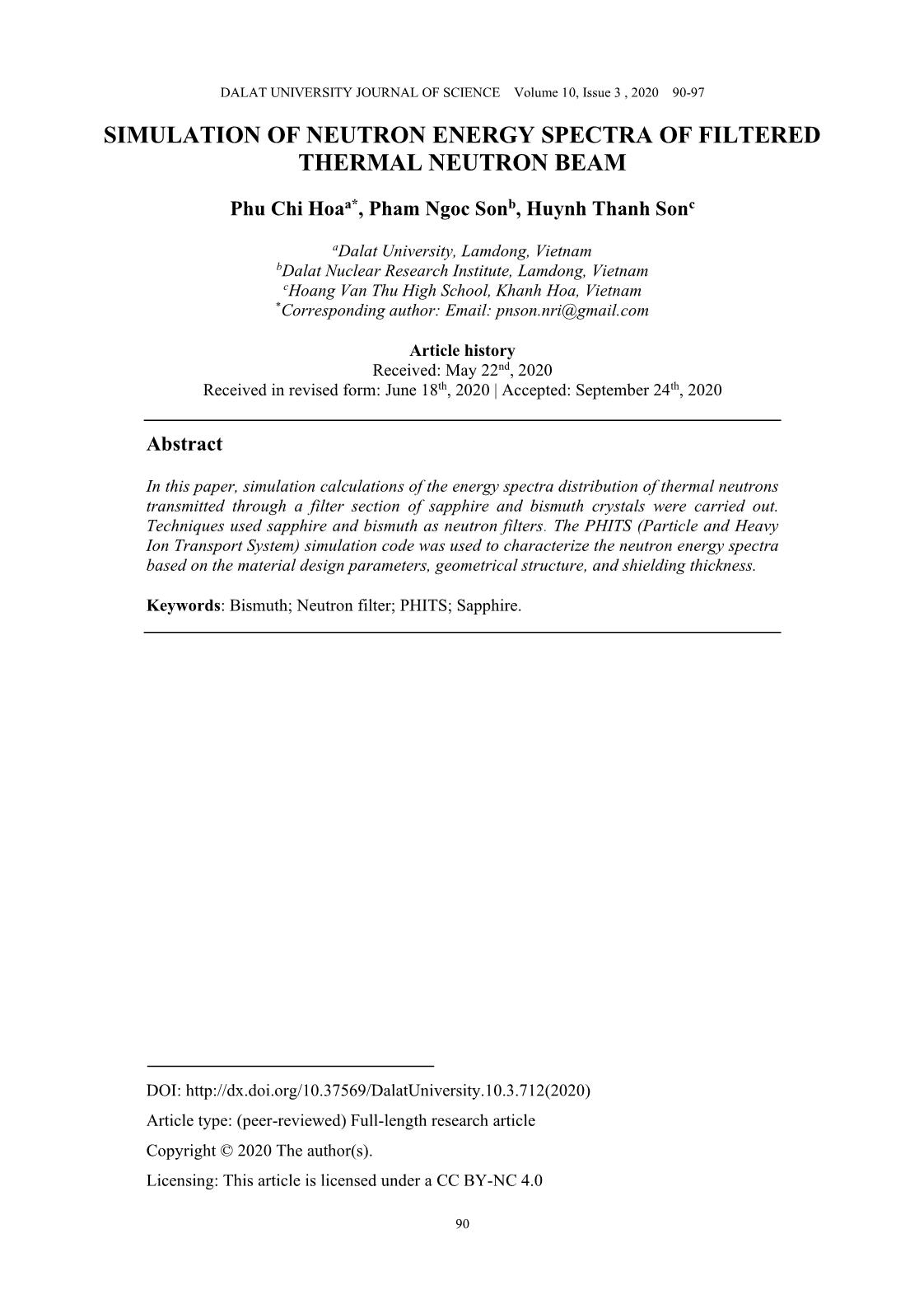
Trang 1
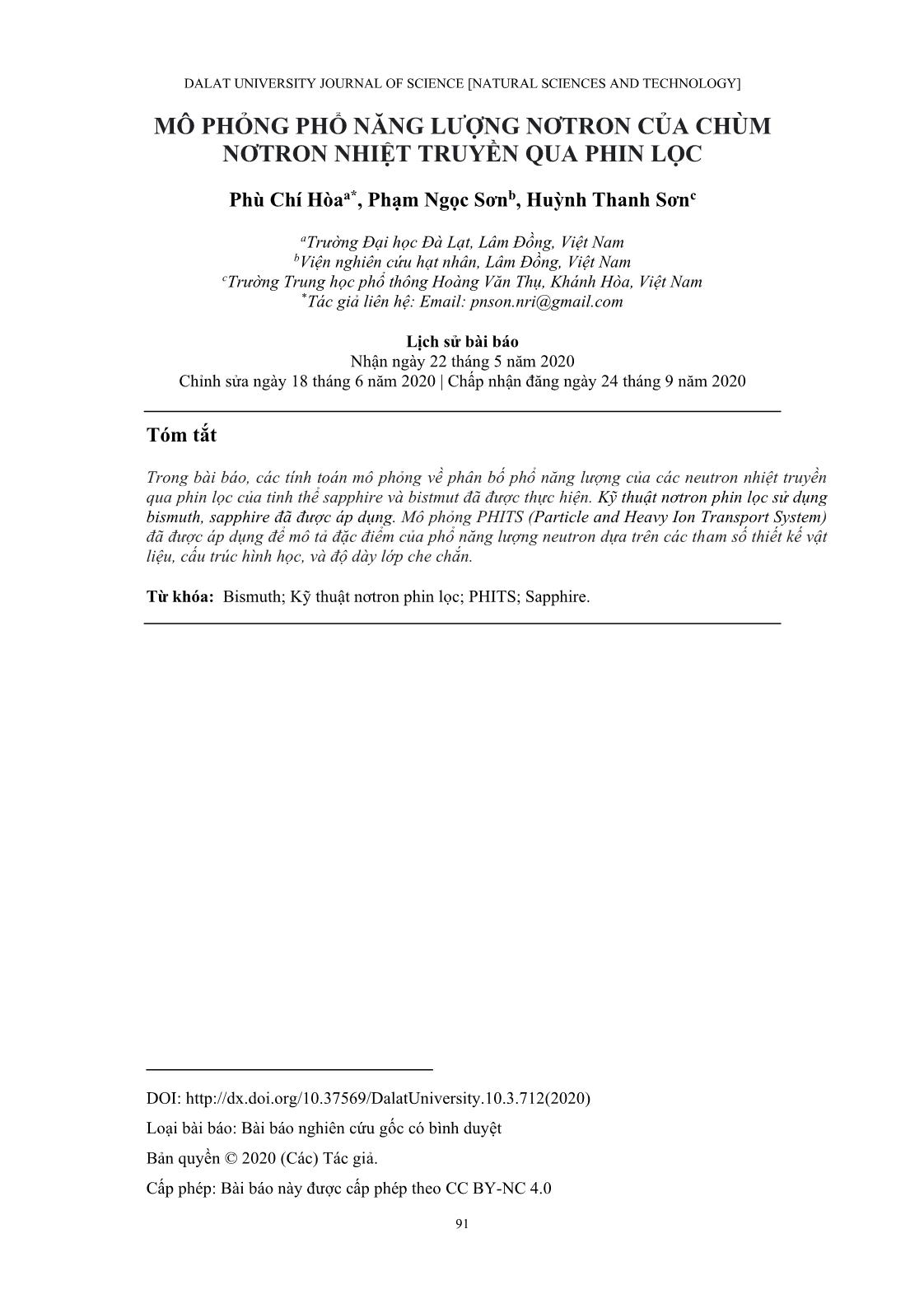
Trang 2
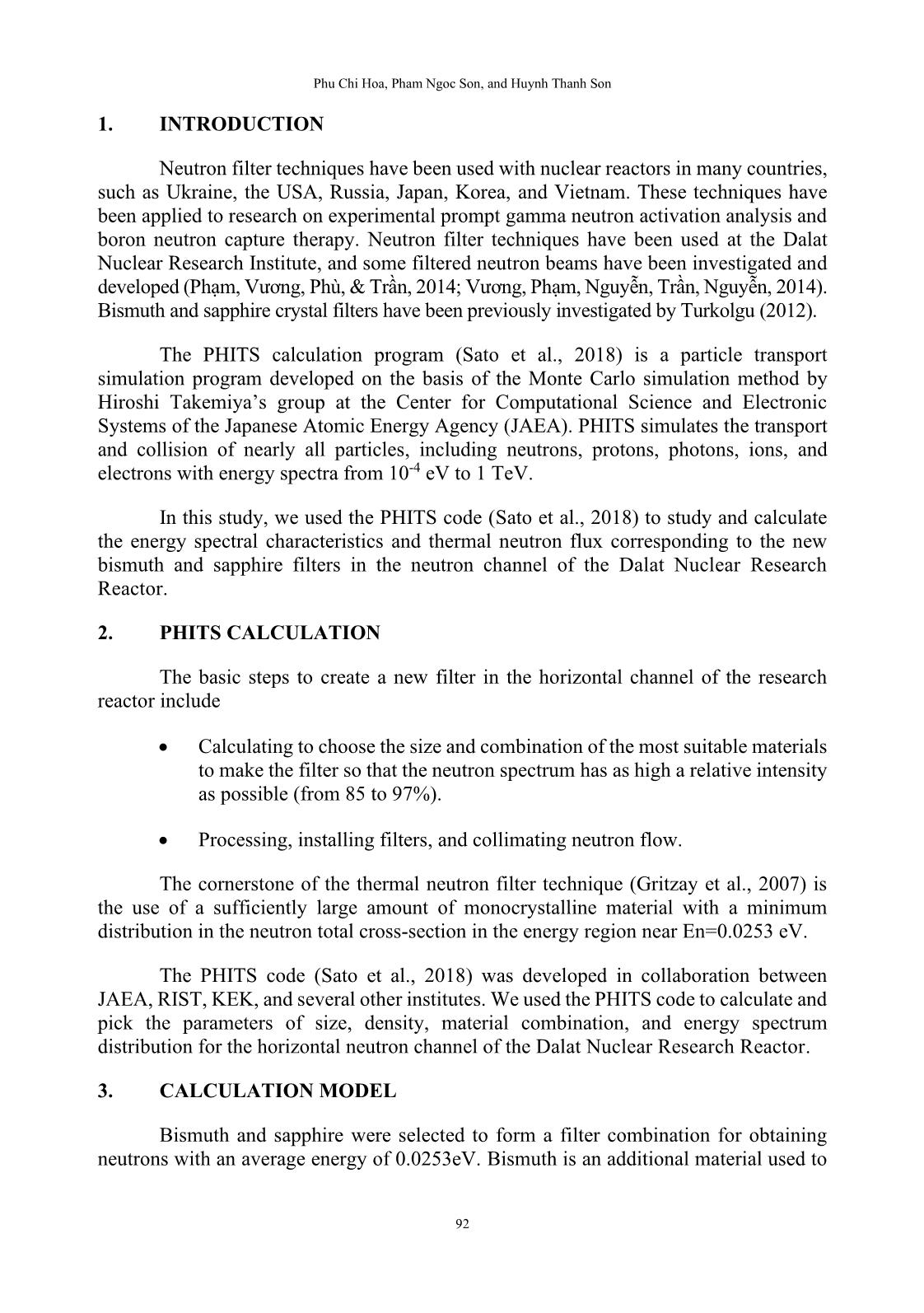
Trang 3
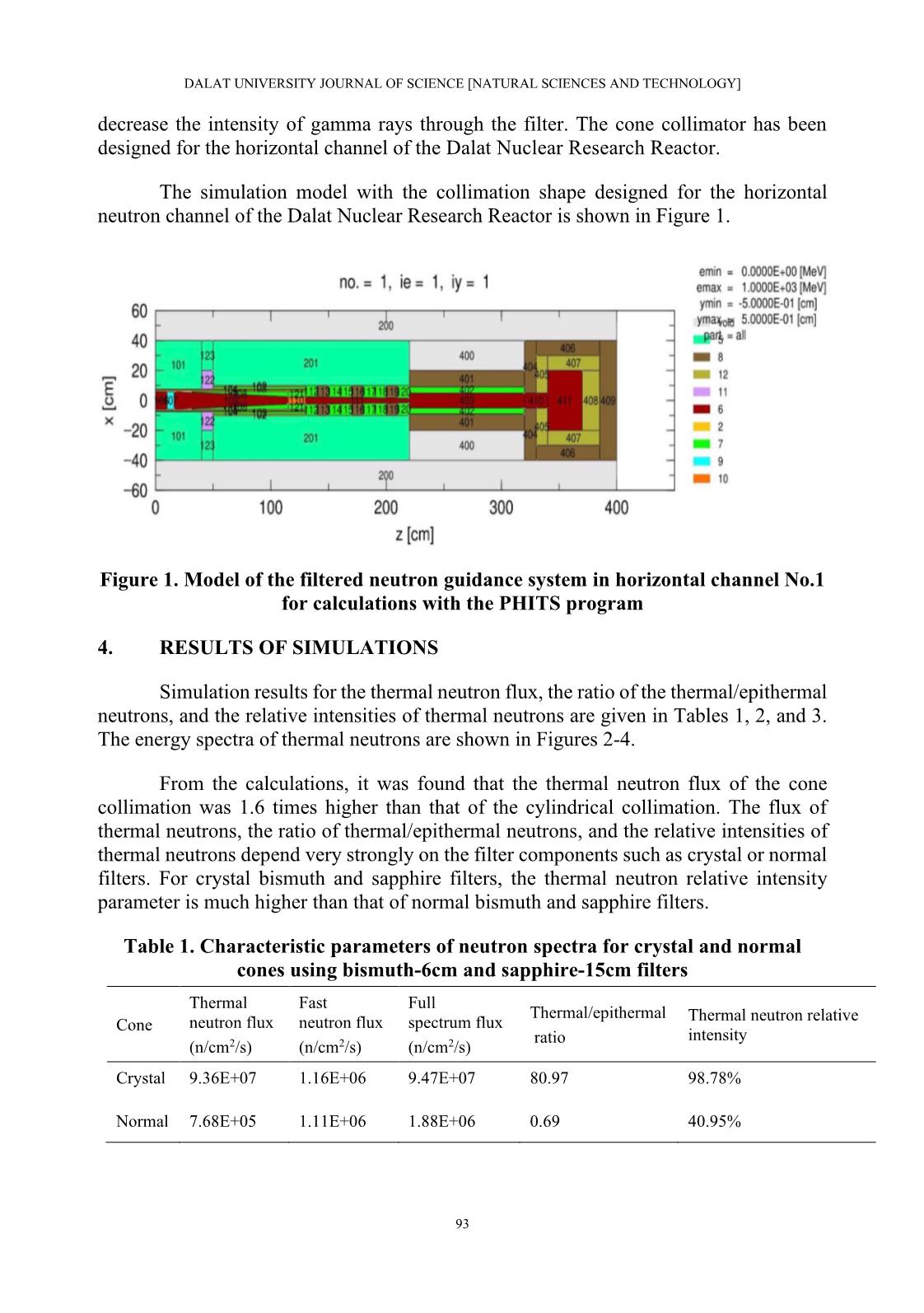
Trang 4
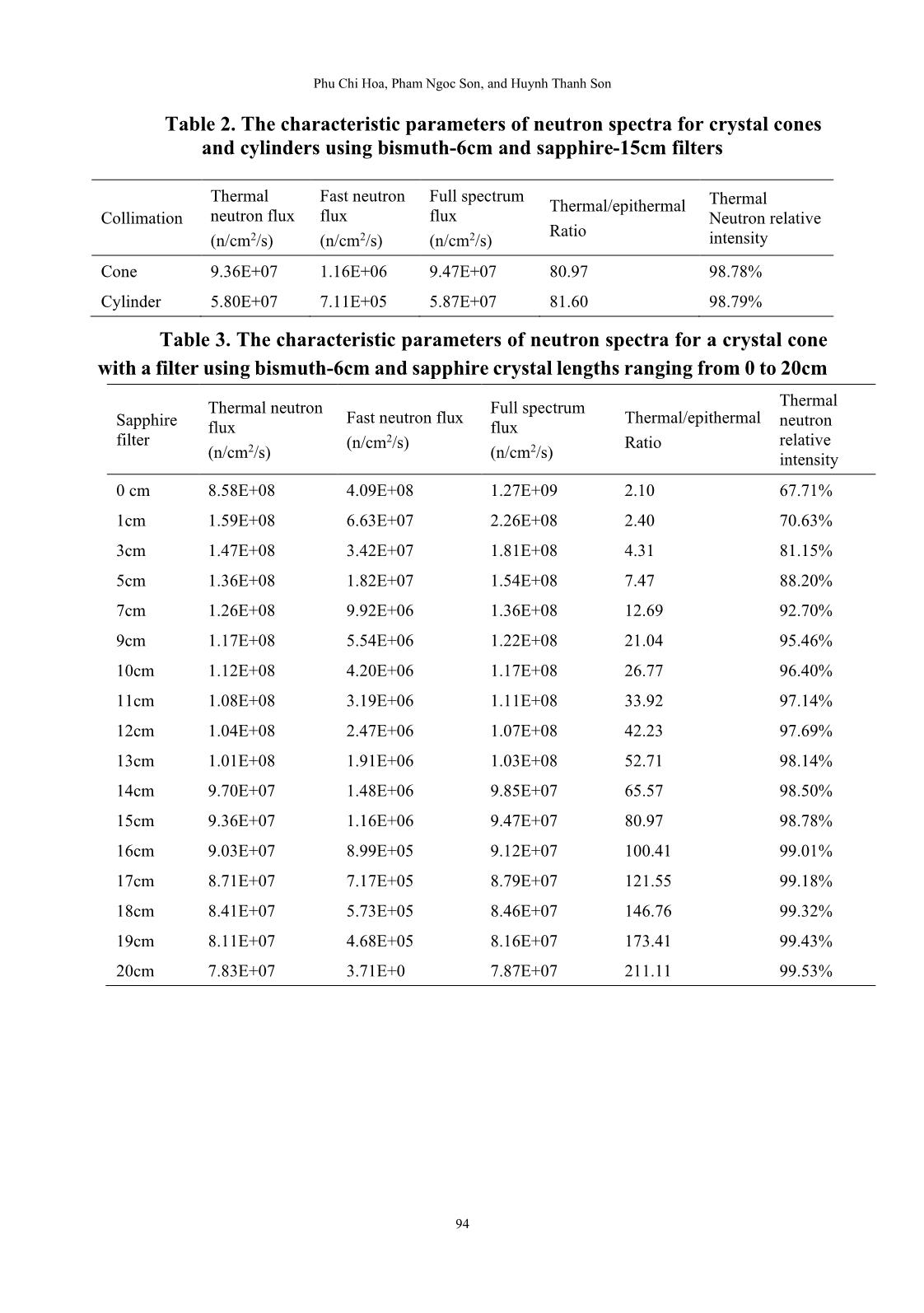
Trang 5
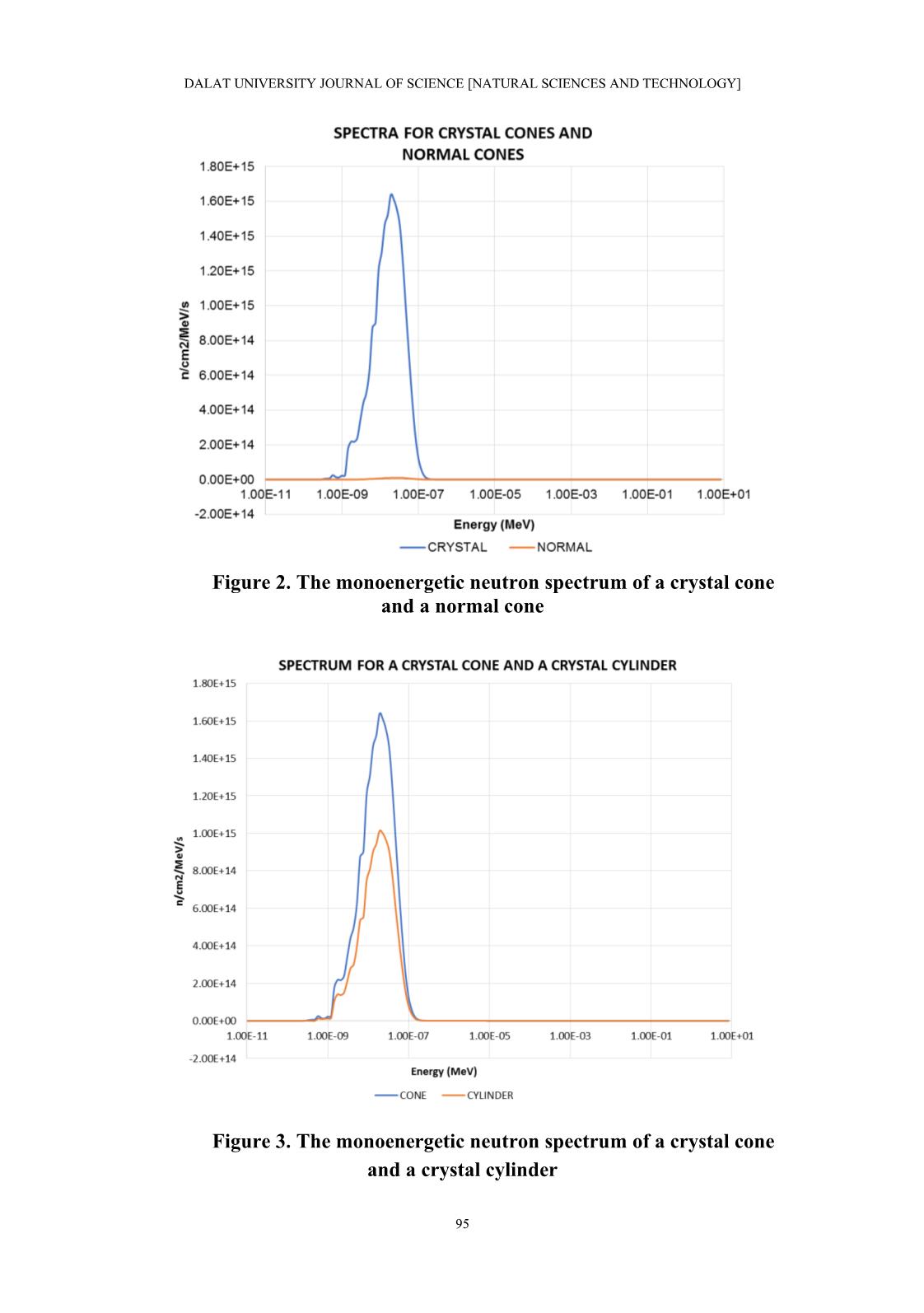
Trang 6
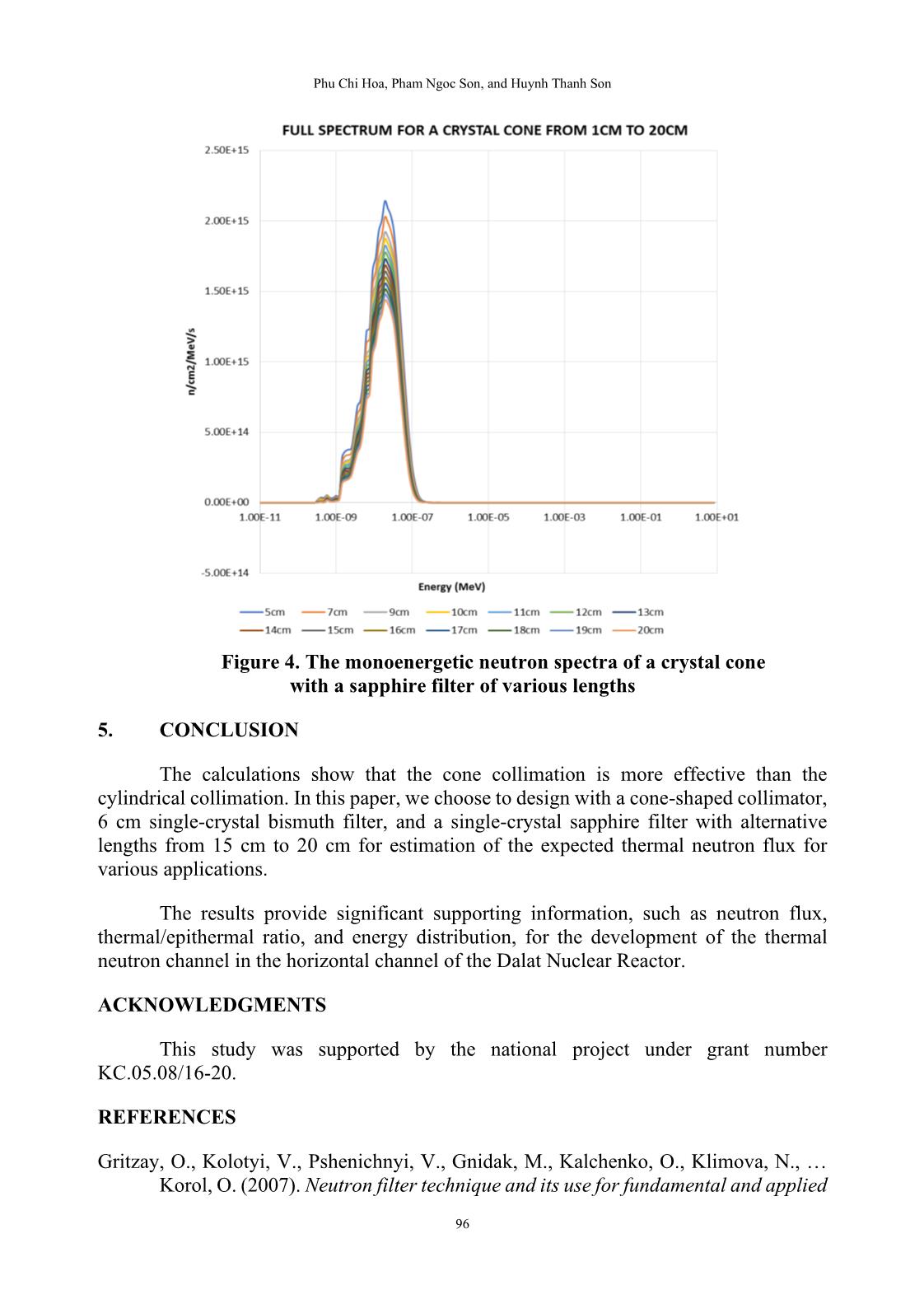
Trang 7
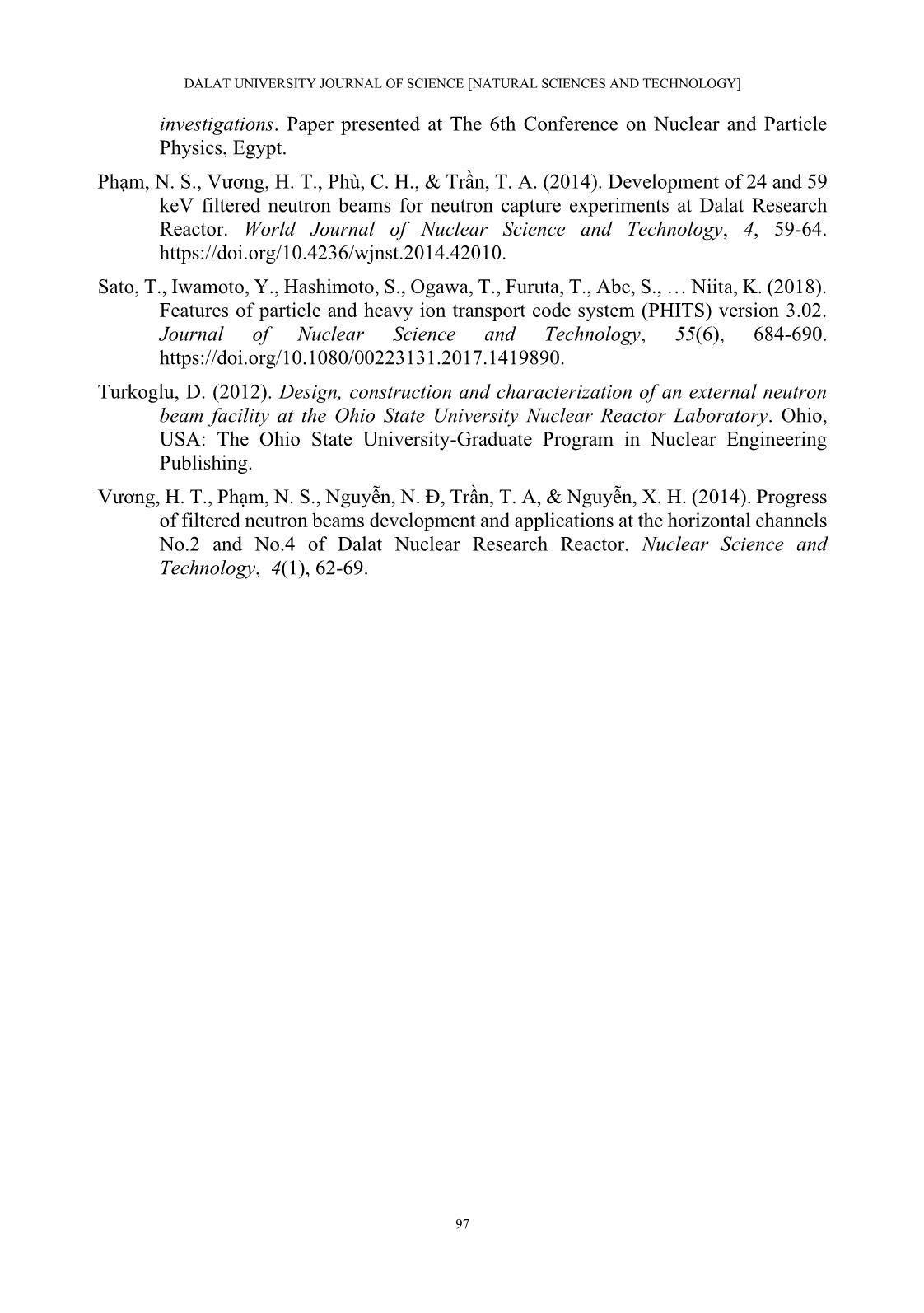
Trang 8
Tóm tắt nội dung tài liệu: Mô phỏng phổ năng lượng nơtron của chùm nơtron nhiệt truyền qua phin lọc

DALAT UNIVERSITY JOURNAL OF SCIENCE Volume 10, Issue 3 , 2020 90-97 90 SIMULATION OF NEUTRON ENERGY SPECTRA OF FILTERED THERMAL NEUTRON BEAM Phu Chi Hoaa*, Pham Ngoc Sonb, Huynh Thanh Sonc aDalat University, Lamdong, Vietnam bDalat Nuclear Research Institute, Lamdong, Vietnam cHoang Van Thu High School, Khanh Hoa, Vietnam *Corresponding author: Email: pnson.nri@gmail.com Article history Received: May 22nd, 2020 Received in revised form: June 18th, 2020 | Accepted: September 24th, 2020 Abstract In this paper, simulation calculations of the energy spectra distribution of thermal neutrons transmitted through a filter section of sapphire and bismuth crystals were carried out. Techniques used sapphire and bismuth as neutron filters. The PHITS (Particle and Heavy Ion Transport System) simulation code was used to characterize the neutron energy spectra based on the material design parameters, geometrical structure, and shielding thickness. Keywords: Bismuth; Neutron filter; PHITS; Sapphire. DOI: Article type: (peer-reviewed) Full-length research article Copyright © 2020 The author(s). Licensing: This article is licensed under a CC BY-NC 4.0 DALAT UNIVERSITY JOURNAL OF SCIENCE [NATURAL SCIENCES AND TECHNOLOGY] 91 MÔ PHỎNG PHỔ NĂNG LƯỢNG NƠTRON CỦA CHÙM NƠTRON NHIỆT TRUYỀN QUA PHIN LỌC Phù Chí Hòaa*, Phạm Ngọc Sơnb, Huỳnh Thanh Sơnc aTrường Đại học Đà Lạt, Lâm Đồng, Việt Nam bViện nghiên cứu hạt nhân, Lâm Đồng, Việt Nam cTrường Trung học phổ thông Hoàng Văn Thụ, Khánh Hòa, Việt Nam *Tác giả liên hệ: Email: pnson.nri@gmail.com Lịch sử bài báo Nhận ngày 22 tháng 5 năm 2020 Chỉnh sửa ngày 18 tháng 6 năm 2020 | Chấp nhận đăng ngày 24 tháng 9 năm 2020 Tóm tắt Trong bài báo, các tính toán mô phỏng về phân bố phổ năng lượng của các neutron nhiệt truyền qua phin lọc của tinh thể sapphire và bistmut đã được thực hiện. Kỹ thuật nơtron phin lọc sử dụng bismuth, sapphire đã được áp dụng. Mô phỏng PHITS (Particle and Heavy Ion Transport System) đã được áp dụng để mô tả đặc điểm của phổ năng lượng neutron dựa trên các tham số thiết kế vật liệu, cấu trúc hình học, và độ dày lớp che chắn. Từ khóa: Bismuth; Kỹ thuật nơtron phin lọc; PHITS; Sapphire. DOI: Loại bài báo: Bài báo nghiên cứu gốc có bình duyệt Bản quyền © 2020 (Các) Tác giả. Cấp phép: Bài báo này được cấp phép theo CC BY-NC 4.0 Phu Chi Hoa, Pham Ngoc Son, and Huynh Thanh Son 92 1. INTRODUCTION Neutron filter techniques have been used with nuclear reactors in many countries, such as Ukraine, the USA, Russia, Japan, Korea, and Vietnam. These techniques have been applied to research on experimental prompt gamma neutron activation analysis and boron neutron capture therapy. Neutron filter techniques have been used at the Dalat Nuclear Research Institute, and some filtered neutron beams have been investigated and developed (Phạm, Vương, Phù, & Trần, 2014; Vương, Phạm, Nguyễn, Trần, Nguyễn, 2014). Bismuth and sapphire crystal filters have been previously investigated by Turkolgu (2012). The PHITS calculation program (Sato et al., 2018) is a particle transport simulation program developed on the basis of the Monte Carlo simulation method by Hiroshi Takemiya’s group at the Center for Computational Science and Electronic Systems of the Japanese Atomic Energy Agency (JAEA). PHITS simulates the transport and collision of nearly all particles, including neutrons, protons, photons, ions, and electrons with energy spectra from 10-4 eV to 1 TeV. In this study, we used the PHITS code (Sato et al., 2018) to study and calculate the energy spectral characteristics and thermal neutron flux corresponding to the new bismuth and sapphire filters in the neutron channel of the Dalat Nuclear Research Reactor. 2. PHITS CALCULATION The basic steps to create a new filter in the horizontal channel of the research reactor include • Calculating to choose the size and combination of the most suitable materials to make the filter so that the neutron spectrum has as high a relative intensity as possible (from 85 to 97%). • Processing, installing filters, and collimating neutron flow. The cornerstone of the thermal neutron filter technique (Gritzay et al., 2007) is the use of a sufficiently large amount of monocrystalline material with a minimum distribution in the neutron total cross-section in the energy region near En=0.0253 eV. The PHITS code (Sato et al., 2018) was developed in collaboration between JAEA, RIST, KEK, and several other institutes. We used the PHITS code to calculate and pick the parameters of size, density, material combination, and energy spectrum distribution for the horizontal neutron channel of the Dalat Nuclear Research Reactor. 3. CALCULATION MODEL Bismuth and sapphire were selected to form a filter combination for obtaining neutrons with an average energy of 0.0253eV. Bismuth is an additional material used to DALAT UNIVERSITY JOURNAL OF SCIENCE [NATURAL SCIENCES AND TECHNOLOGY] 93 decrease the intensity of gamma rays through the filter. The cone collimator has been designed for the horizontal channel of the Dalat Nuclear Research Reactor. The simulation model with the collimation shape designed for the horizontal neutron channel of the Dalat Nuclear Research Reactor is shown in Figure 1. Figure 1. Model of the filtered neutron guidance system in horizontal channel No.1 for calculations with the PHITS program 4. RESULTS OF SIMULATIONS Simulation results for the thermal neutron flux, the ratio of the thermal/epithermal neutrons, and the relative intensities of thermal neutrons are given in Tables 1, 2, and 3. The energy spectra of thermal neutrons are shown in Figures 2-4. From the calculations, it was found that the thermal neutron flux of the cone collimation was 1.6 times higher than that of the cylindrical collimation. The flux of thermal neutrons, the ratio of thermal/epithermal neutrons, and the relative intensities of thermal neutrons depend very strongly on the filter components such as crystal or normal filters. For crystal bismuth and sapphire filters, the thermal neutron relative intensity parameter is much higher than that of normal bismuth and sapphire filters. Table 1. Characteristic parameters of neutron spectra for crystal and normal cones using bismuth-6cm and sapphire-15cm filters Cone Thermal neutron flux (n/cm2/s) Fast neutron flux (n/cm2/s) Full spectrum flux (n/cm2/s) Thermal/epithermal ratio Thermal neutron relative intensity Crystal 9.36E+07 1.16E+06 9.47E+07 80.97 98.78% Normal 7.68E+05 1.11E+06 1.88E+06 0.69 40.95% Phu Chi Hoa, Pham Ngoc Son, and Huynh Thanh Son 94 Table 2. The characteristic parameters of neutron spectra for crystal cones and cylinders using bismuth-6cm and sapphire-15cm filters Collimation Thermal neutron flux (n/cm2/s) Fast neutron flux (n/cm2/s) Full spectrum flux (n/cm2/s) Thermal/epithermal Ratio Thermal Neutron relative intensity Cone 9.36E+07 1.16E+06 9.47E+07 80.97 98.78% Cylinder 5.80E+07 7.11E+05 5.87E+07 81.60 98.79% Table 3. The characteristic parameters of neutron spectra for a crystal cone with a filter using bismuth-6cm and sapphire crystal lengths ranging from 0 to 20cm Sapphire filter Thermal neutron flux (n/cm2/s) Fast neutron flux (n/cm2/s) Full spectrum flux (n/cm2/s) Thermal/epithermal Ratio Thermal neutron relative intensity 0 cm 8.58E+08 4.09E+08 1.27E+09 2.10 67.71% 1cm 1.59E+08 6.63E+07 2.26E+08 2.40 70.63% 3cm 1.47E+08 3.42E+07 1.81E+08 4.31 81.15% 5cm 1.36E+08 1.82E+07 1.54E+08 7.47 88.20% 7cm 1.26E+08 9.92E+06 1.36E+08 12.69 92.70% 9cm 1.17E+08 5.54E+06 1.22E+08 21.04 95.46% 10cm 1.12E+08 4.20E+06 1.17E+08 26.77 96.40% 11cm 1.08E+08 3.19E+06 1.11E+08 33.92 97.14% 12cm 1.04E+08 2.47E+06 1.07E+08 42.23 97.69% 13cm 1.01E+08 1.91E+06 1.03E+08 52.71 98.14% 14cm 9.70E+07 1.48E+06 9.85E+07 65.57 98.50% 15cm 9.36E+07 1.16E+06 9.47E+07 80.97 98.78% 16cm 9.03E+07 8.99E+05 9.12E+07 100.41 99.01% 17cm 8.71E+07 7.17E+05 8.79E+07 121.55 99.18% 18cm 8.41E+07 5.73E+05 8.46E+07 146.76 99.32% 19cm 8.11E+07 4.68E+05 8.16E+07 173.41 99.43% 20cm 7.83E+07 3.71E+0 7.87E+07 211.11 99.53% DALAT UNIVERSITY JOURNAL OF SCIENCE [NATURAL SCIENCES AND TECHNOLOGY] 95 Figure 2. The monoenergetic neutron spectrum of a crystal cone and a normal cone Figure 3. The monoenergetic neutron spectrum of a crystal cone and a crystal cylinder Phu Chi Hoa, Pham Ngoc Son, and Huynh Thanh Son 96 Figure 4. The monoenergetic neutron spectra of a crystal cone with a sapphire filter of various lengths 5. CONCLUSION The calculations show that the cone collimation is more effective than the cylindrical collimation. In this paper, we choose to design with a cone-shaped collimator, 6 cm single-crystal bismuth filter, and a single-crystal sapphire filter with alternative lengths from 15 cm to 20 cm for estimation of the expected thermal neutron flux for various applications. The results provide significant supporting information, such as neutron flux, thermal/epithermal ratio, and energy distribution, for the development of the thermal neutron channel in the horizontal channel of the Dalat Nuclear Reactor. ACKNOWLEDGMENTS This study was supported by the national project under grant number KC.05.08/16-20. REFERENCES Gritzay, O., Kolotyi, V., Pshenichnyi, V., Gnidak, M., Kalchenko, O., Klimova, N., Korol, O. (2007). Neutron filter technique and its use for fundamental and applied DALAT UNIVERSITY JOURNAL OF SCIENCE [NATURAL SCIENCES AND TECHNOLOGY] 97 investigations. Paper presented at The 6th Conference on Nuclear and Particle Physics, Egypt. Phạm, N. S., Vương, H. T., Phù, C. H., & Trần, T. A. (2014). Development of 24 and 59 keV filtered neutron beams for neutron capture experiments at Dalat Research Reactor. World Journal of Nuclear Science and Technology, 4, 59-64. https://doi.org/10.4236/wjnst.2014.42010. Sato, T., Iwamoto, Y., Hashimoto, S., Ogawa, T., Furuta, T., Abe, S., Niita, K. (2018). Features of particle and heavy ion transport code system (PHITS) version 3.02. Journal of Nuclear Science and Technology, 55(6), 684-690. https://doi.org/10.1080/00223131.2017.1419890. Turkoglu, D. (2012). Design, construction and characterization of an external neutron beam facility at the Ohio State University Nuclear Reactor Laboratory. Ohio, USA: The Ohio State University-Graduate Program in Nuclear Engineering Publishing. Vương, H. T., Phạm, N. S., Nguyễn, N. Đ, Trần, T. A, & Nguyễn, X. H. (2014). Progress of filtered neutron beams development and applications at the horizontal channels No.2 and No.4 of Dalat Nuclear Research Reactor. Nuclear Science and Technology, 4(1), 62-69.
File đính kèm:
 mo_phong_pho_nang_luong_notron_cua_chum_notron_nhiet_truyen.pdf
mo_phong_pho_nang_luong_notron_cua_chum_notron_nhiet_truyen.pdf

